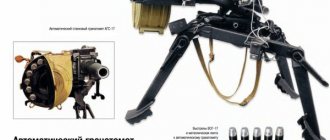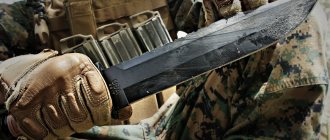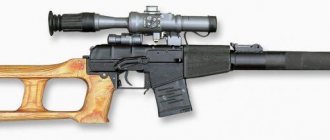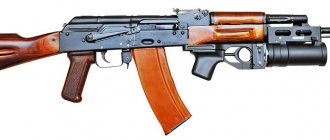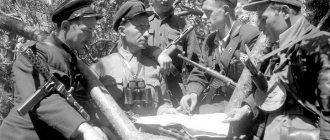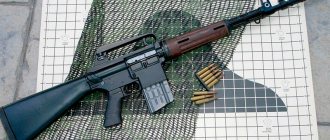Modern Russian anti-tank grenade launchers at a weapons exhibition During the First World War, advancing infantry with small arms could be stopped and pinned to the ground relatively easily by a single machine gun firing from a minimally fortified position. Armored cars had the same paralyzing effect - rifles were powerless against them. Soldiers of modern armies in such situations will no longer wait for artillery to approach, because they have grenade launchers - a universal and powerful weapon that greatly increases the capabilities of troops both on the offensive and in defense. This type of weapon is very “many-faced” - grenade launchers differ in their principle of operation, purpose, and dimensions. They have one thing in common: the target is hit not by the kinetic energy of the projectile, but by the products of the explosion - excess pressure, high temperature or fragments.
History of creation
The first type of weapon that to some extent resembled a grenade launcher was hand-held mortars. They appeared at the turn of the 15th and 16th centuries. The unknown inventor of a new weapon for those times simply replaced the small cannonball that was used to load the squeaks with a grenade loaded with black powder. Hand-held mortars can be seen today in many museums, however, they usually did not find wide use among the troops. In the Russian army during the reign of Peter I, this weapon was introduced as a means of self-defense for artillerymen, but was then considered unsuitable for field battles.
Several different versions of a hand-held mortar - a prototype of a grenade launcher
The low efficiency of hand-held mortars was due to very strong recoil: they had to shoot while resting the back of the barrel on the ground or on the deck of a ship. In essence, this weapon was more like a small mortar. In addition, grenades of those times had a low destructive effect.
Another prototype of a modern grenade launcher was a gun patented in 1718 by London lawyer James Puckle. This invention can also be considered an early ancestor of the machine gun or even the automatic shotgun. The “gun” was equipped with a quick-change drum, which housed 11 ready-to-fire charges. The caliber is large enough to replace the large bullets proposed by Pakl with small grenades. Contemporaries did not appreciate the invention: it was too complex for the 18th century.
"Pakla's Gun" in the museum. It is clearly visible that the charges are not inferior in size to grenade launcher rounds
At the beginning of the twentieth century, the old idea of a hand-held mortar was returned, but at a qualitatively different level. The first muzzle grenade launchers appeared, which were a shortened rifle with a primitive launcher attached to it. The most widespread, however, were homemade products made right in the trenches of the First World War. Sometimes soldiers took an ordinary hand grenade, soldered an old ramrod to its bottom, and then inserted the resulting structure into the barrel of a rifle and fired with a blank cartridge.
Soon the production of such muzzle grenade launchers was, as they say, streamlined - homemade products disfigured rifle barrels, so it was more expedient to use special overhead devices.
The simplest rifle grenade from the First World War.
A regular ramrod is soldered into the back. In World War II, tanks quickly became the main type of weapon. The infantry initially did not have effective means of destroying armored vehicles. Anti-tank rifles could be seen as a temporary measure due to extreme necessity. This situation changed only after the advent of anti-tank grenade launchers. Already their first models, such as the American Bazooka or the German Panzerfaust, significantly increased the vulnerability of armored vehicles.
In the post-war years, anti-tank grenade launchers were actively improved. A particularly successful model was the Soviet RPG-7, which is still in use today, and in terms of its prevalence in different countries of the world is comparable only to the Kalashnikov assault rifle. At the same time, the United States was implementing an ambitious program to create new types of infantry weapons and ammunition, known by the acronym SPIW (Special Purpose Individual Weapon). Part of it was the NIBLICK project, within the framework of which a fragmentation grenade with a caliber of 40 millimeters was developed.
American grenade 40x46 mm. Used in under-barrel and hand-held grenade launchers, it became the prototype of a shot for an easel automatic grenade launcher
This ammunition later made it possible to create several new types of weapons at once:
- Light infantry grenade launcher. Both single-shot and multi-shot models are available;
- Underbarrel grenade launcher. Attaches to an assault rifle and significantly expands its capabilities;
- Automatic easel grenade launcher. A powerful infantry support weapon. Capable of firing in bursts.
Later, at the turn of the 60-70s of the last century, similar systems appeared in the USSR.
Recently, the development of grenade launchers has been going in two main directions. The first of them is building up and expanding the capabilities of anti-tank models. The second is the improvement of small-caliber fragmentation grenades. The American promising OICW complex managed to increase the flight range of such ammunition to 2000 meters.
Motorized rifle company as part of a brigade
The MSR staff in a brigade is similar to the MSR in a regiment, only reinforced by a grenade launcher platoon.
Composition of the MSR grenade launcher platoon
The grenade launcher platoon has 26 personnel, including the platoon commander. Deputy commander, three squads of 8 people each.
Armament of a grenade launcher platoon
- AK74 – 20 units;
- AGS-17 – 6 units;
- BMP - 3 vehicles;
The BMP is equipped with: 30-mm cannon (2A42) – 3 units, PKT – 3 units, ATGM – 3 units.
In total, the MSR staff of the battalion consists of 126 people.
Armament of the anti-tank platoon:
- PKM – 3 units;
- SVD – 3 units;
- RPK 74 – 9 units;
- AK74 – 96 units;
- RPG-7v – 9 units;
- AGS-17 – 6 units;
- BMP - 14 units;
- Gun 2A42 – 14 units;
- PCT – 14 units;
- ATGM – 14 units.
Especially for the “Military Collection” site.
Related posts:
- Unit defense at night
- MDF squad on the offensive
- Platoon defense at home: urban defense
- Motorized rifle battalion of the Russian Army
The main purpose
The list of tasks that are successfully solved using various grenade launchers speaks for itself:
- Destruction of all types of moving small targets (tanks, armored vehicles, infantry fighting vehicles, trucks, river and sea boats, etc.);
- Suppression and destruction of fortified firing points (bunkers, armored caps, pillboxes and simply machine gun nests);
- Defeat enemy fire weapons and manpower located both in open areas and in trenches, as well as on reverse slopes and in ravines;
- Fight against low-flying enemy aircraft, primarily fire support helicopters.
UH-60 "Black Hawk", shot down in Mogadishu in October 1993. The Americans believe that the helicopter was destroyed by a shot from a grenade launcher.
Of course, there are no grenade launchers that would be able to solve all these problems equally successfully. Each of the subtypes of these weapons has its own specialization.
Design of RPG-7
The RPG-7 is a lightweight dynamo-reactive (no recoil when fired) weapon. The grenade launcher and shot were based on the reusable recoilless launcher and shot with an over-caliber warhead, which had proven themselves in the RPG-2. The grenade launcher consists of a barrel with optical and mechanical sights, a trigger mechanism with a safety catch, and a firing mechanism.
Grenade launcher barrel
The barrel of a grenade launcher consists of a pipe and a pipe and serves to direct the flight of the grenade and remove powder gases when fired. Unlike the RPG-2, the RPG-7 grenade launcher has an extension of the barrel in its middle part - a charging chamber - to more fully utilize the energy of the propellant charge, and a bell in the breech - to ensure recoillessness of the complex.
Trigger mechanism
Trigger mechanism - used to release the hammer, strike the firing pin and engage the safety.
Sights
Mechanical sightMechanical sight - used in case of damage (failure) of the optical sight.
Optical sightThe main one for the RPG-7 is the PGO-7 optical sight (or its modifications PGO-7V, PGO-7V-2, PGO-7V-3). The optical sight is designed to monitor the battlefield, determine the distance to the target, introduce corrections for the range and speed of the target, taking into account the ballistics of various ammunition, and point the grenade launcher at the target, taking into account the corrections. The sight is an optical system of lenses and prisms, enclosed in a sealed metal case filled with dry nitrogen to prevent fogging. The optical sight provides a fixed apparent target magnification of 2.7 times. The sight is equipped with a set of light filters that improve visibility in difficult weather conditions. To prevent unmasking glare from the sun and contamination, the sight is equipped with a rubber cap that fits onto the lens.
The PGO-7V sight reticle has a developed correction scale, as well as a rangefinder scale, which allows you to quickly determine the range to a “tank” type target (2.7 m high). The handwheel provides input of aiming angles in the range of 0 - 51.2 artillery units, and the aiming mark on the reticle: 0 - 45.7. In poor lighting conditions, the sight reticle can be illuminated. The backlight lamp uses galvanic batteries A316 or 2РЦ63. The sight retains its characteristics over a wide temperature range (from −50 to +50 °C), and is also able to withstand high mechanical loads.
Night optical sightThe RPG-7 grenade launcher can be equipped with first-generation night sights (such as the specialized PGN-1 grenade launcher night sight, or the NSPUM universal night sight (product 1PN58)) or second-generation NSPU-3 night sights. For a grenade launcher with a night sight, a light-blocking mechanism is additionally introduced, which prevents the sight from being illuminated by the flame of its own shot.
Universal sighting device The universal sighting device is a mechanical device weighing 0.55 kg for introducing corrections into the optical sight. It has been used since 2001 in grenade launchers of the RPG-7V2 (RPG-7D3) modifications in conjunction with an optical sight. Allows you to significantly increase the target firing range of thermobaric (TBG-7V) and fragmentation (OG-7V) grenades: up to 550 and 700 meters, respectively.
Other types of sights In conjunction with the RPG-7, other sighting devices (including homemade ones) are also used: from homemade mechanical sights to replace damaged original ones, to high-tech laser and collimator sights. Most such devices do not allow for corrections for range and target movement, so they are effective only at short ranges.
Types of grenade launchers
Modern grenade launchers in the world are classified according to several main characteristics, some of which characterize the purpose of the weapon, while others characterize its design features. Due to this approach, one and the same model can be classified as several types of grenade launchers. One of the typical examples is the Soviet LNG-9 “Spear”, which is simultaneously reusable, anti-tank, mounted and jet. Nevertheless, in general, the classification is quite obvious and usually does not raise questions.
Muzzle launchers
Back in 1916, the Russian staff captain Dyakonov created a device that received the ancient name of a hand-held mortar. It was one of the first mass-produced muzzle (rifle) grenade launchers. Similar devices were used in other countries.
Mosin rifle with Dyakonov mortar. I had to shoot from point blank because of the very high recoil
Structurally, the “hand mortar” is a steel pipe (barrel), to the back of which a cup-shaped part is screwed, connected by a narrow part to the so-called neck, which is put directly on the rifle barrel instead of a bayonet. The Dyakonov grenade launcher was rifled, but there were also smooth-bore devices.
The German Schiessbecher “mortar” from World War II had a similar design, which they tried to use to fight armored vehicles. Anti-tank rifle grenades were developed in the USSR and the USA, however, these types of ammunition were used without a “mortar” - a guide rod (“ramrod”) was inserted directly into the barrel.
Serdyuk model 1941 rifle anti-tank grenade
In the 60s, after the advent of under-barrel grenade launchers, interest in muzzle systems noticeably decreased. Nevertheless, even at the beginning of the 2000s, the Israeli army quite actively used ammunition such as VT43 and IMI. These rifle grenades were usually fired from a Galil automatic rifle, now withdrawn from service.
Under-barrel and manual
Quite often, modern assault rifles are additionally equipped with under-barrel grenade launchers. Fire from such weapons is carried out by special ammunition, which contains a warhead and a propellant charge. For the first time, under-barrel grenade launchers appeared in the US Army. These were the M203, which are still used by American soldiers today.
In the USSR, under-barrel grenade launchers appeared in the army only in 1978 under the designation GP-25 “Koster”. A decade later, the army received the GP-30 Obuvka, and at the beginning of the 21st century - the GP-34. All these grenade launchers use VOG-25 rounds of various modifications.
M4 automatic carbine with M203 grenade launcher
The main advantage of under-barrel systems, compared to muzzle systems, is their ease of use. The soldier does not need to store special blank cartridges, and he can open fire at any time from either a grenade launcher or an assault rifle.
It should be noted that in the United States, a slightly different weapon was initially created for the use of 40-mm caliber shots - the M79 single-shot hand grenade launcher. Its use during the Vietnam War turned out to be quite successful, but the under-barrel system was considered much more convenient. However, the story of the M79 did not end there - it was actively supplied to different countries around the world, including South Africa. It was in this country that a new interesting grenade launcher was created - Milkor M32. It used the same ammunition as the M79, but was multi-shot, made in a revolver design.
Russian multi-charge grenade launcher RG-6
A few years later, African gunsmiths began to have imitators. First, the MM-1 was developed in the USA, then the experimental “Avalanche” hand grenade launcher was demonstrated in Bulgaria, and in the 90s the RG-6 was created for the Russian army. All these systems use the same revolving reloading scheme, differing in the details of its implementation.
Rocket launchers
In 1910, the first recoilless rifle was invented in the United States. Its idea was simple: the usually closed breech of the gun barrel was opened, so that part of the powder gases flowed back when fired, compensating for the recoil. This sharply reduced the mass of the artillery system and greatly simplified it.
Modern rocket-propelled grenade launchers have approximately the same device, the only difference is that the fired projectile is equipped with its own engine. Sometimes its work begins and ends inside the launch tube, like the RPG-18 Mukha. There is a completely different example - this is the RPG-7, in which the grenade flies out of the barrel due to the activation of the expelling charge, and the engine is turned on already in flight.
The LNG-9 “Spear” rocket launcher, made according to the classic “recoilless” design. Frankly outdated weapons, but still used by the Ukrainian army
Initially, recoilless models were created as a universal artillery system, but modern grenade launchers are designed primarily to combat enemy armored vehicles.
Anti-tank
Shortly before World War II, the world's first combat-usable cumulative projectiles were created. Compared to previous types of anti-tank ammunition, they had one very important advantage: even if such a projectile reached the target at a speed close to zero, armor penetration remained at the same level. It is this feature that made it possible to create quite lightweight and easy-to-use anti-tank grenade launchers. It was enough to make the simplest recoilless rifle and equip it with cumulative projectiles.
The first anti-tank grenade launcher was the M1 Bazooka, developed for the US Army. German “faustpatrons” were created with an eye on these American weapons, but were much more primitive - they did not have their own jet engine, which reduced the firing distance to 50 meters. Subsequently, more advanced and long-range “ofenrors” and “panzerschreks” appeared.
Soviet anti-tank classic - RPG-7. Used everywhere
The most famous anti-tank grenade launcher is, of course, the Soviet RPG-7. Entered into service in 1961, it remains a huge threat to any armored target today. When using tandem shots PG-7VR "Resume", this grenade launcher is capable of destroying a tank protected by active armor. In addition, there are fragmentation and thermobaric rounds.
The world's most powerful anti-tank grenade launcher is the Russian RPG-28 Klyukva. This weapon successfully overcomes reactive armor and penetrates up to one meter of homogeneous armor.
Reusable
Some grenade launchers are designed for single use. A soldier can fire a shot at a target and then immediately eject the launch tube. In the Russian army, it is customary to call such disposable weapons, for example, the RPG-18 “Mukha”, not grenade launchers, but simply grenades.
American disposable grenade launcher M72 Law. Became a model for the creation of the RPG-18 “Fly”
Reusable systems can be recharged and reused. These include, in particular, the Russian grenade launchers RPG-32 “Barkas”, RPG-29 “Vampire”, RPG-7, as well as all “grenade launchers”.
Easel grenade launchers
Most types of grenade launchers are hand-held weapons that can be used and carried by one person. But there are also heavier systems designed for burst fire. These are mounted grenade launchers that use ammunition that is similar in appearance to VOG rounds, but has slightly different dimensions. One of the first examples of such weapons was developed by the Soviet designer Taubin in the late 30s of the last century. This grenade launcher did not go into production because the military did not see the need for it.
Taubin automatic grenade launcher. Despite the archaic design, it is in many ways similar to its “successors”
In 1968, during the fighting in Vietnam, the US Army began to use a new type of weapon, which at first was installed mainly on river boats. It was an easel automatic grenade launcher Mk 19. The new product turned out to be quite successful, it was highly appreciated not only by the Americans themselves, but also by experts from other countries. Already in 1971, the AGS-17 “Plamya” was put into service with the Soviet army, the characteristics of which were in no way inferior to the Mk 19.
Over time, the Russian automatic mounted grenade launcher was approximately twice as light - the new model received the designation AGS-30. The latest modification of this weapon appeared in 2010 under the designation AGS-40.
Training in firing from a mounted Mk19 grenade launcher
It should be taken into account that in the past, mounted anti-tank grenade launchers were also created in the USA and the USSR. They were heavy and bulky, without being very powerful. Today, the need for such weapons has disappeared, since anti-tank guided missile systems with a similar or even lower mass have much higher efficiency.
Grenade launchers have significantly changed the tactics of modern combat. They radically strengthened the anti-tank defense of the troops, and also made it possible to provide soldiers with powerful, operational and flexible fire support. The variety of grenade launchers makes them a universal means of achieving victory in any battle. Today it is difficult to predict in what direction the further development of these weapons will go, but we can say for sure that in the foreseeable future they will certainly retain a strong position in all armies of the world.
Grenade launchers
USSR/Russia
- 30 mm Automatic hand grenade launcher Baryshev
- 30 mm Product D
- 30 mm Product DM
- 30 mm BS-1 RGA-86 “Silence”/BS-1M 6S1 “Canary”
- 30 mm AGS-17 “Flame”
- 30 mm AGS-30
- 30 mm handheld "sniper" grenade launcher TKB-0249 "Crossbow"
- 33 mm RGS-33
- 37 mm RK MM/RK BM/DR
- 40 mm Grenade launcher-shovel “Option”
- 40 mm "Pencil case"
- 40 mm TKB-0134 “Goat”
- 40 mm AGS-40 "Balkan" (6G27)
- 40 mm BP-30
- 40 mm RGM-40 “Kastet”
- 40 mm RPG-2
- 40 mm RG-6/6G30
- 40 mm GP-25 “Koster”
- 40 mm GP-30 “Obuvka” / GP-30U “Granat” / GP-30M
- 40 mm GP-34
- 40 mm RPG-7/7D
- 40.7 mm VG-44/45
- 43 mm OKG-40 "Iskra"
- 43 mm GM-93/94
- 43 mm DP-61 "Duel"
- 45 mm DP-64 "Nepryadva"
- 50 mm RGS-50M
- 50 mm Grenade launcher complex "Showcase"
- 55 mm MRG-1 "Ogonyok"
- 55 mm DP-65
- 58 mm RPG-16 "Udar"
- 62 mm "Bur"
- 64 mm RPG-18 "Fly"
- 72 mm RPG-22 "Netto"
- 72 mm RPG-26 "Aglen"
- 72.5 mm RShG-2
- 72.5 mm MRO-A
- 73 mm SPG-9/9-M “Spear”
- 90 mm RPO-M/PDM-A “Shmel-M”
- 93 mm RPO-A "Shmel"
- 105 mm RPG-27 "Tavolga"
- 105 mm RShG-1
- 105 mm RPG-29 “Vampire”
- 105 mm RPG-30 "Hook"
- 105 mm RMG
- 105 mm (72 mm) RPG-32 "Hashim"
- 105.2 mm RPO "Lynx"
- 125 mm RPG-28 "Cranberry"
USA
- 20mm XM29 OICW
- 22mm M7/M7A1/M7A2/M7A3
- 22mm M8
- 25mm XM307 ACSW
- 25mm XM-25
- 25 mm Barrett XM109
- 37 mm Federal grenade launcher
- 37/40mm Deuce Launcher
- 40 mm M-32
- 40 mm M-203
- 40mm M-320/M-203PI
- 40 mm Airtronic USA RPG-7/Mk.777
- 40 mm T148E1 / T148E2
- 40 mm M-79/M129
- 40 mm Mk-18
- 40 mm MK-19
- 40 mm Mk-20
- 40 mm StrikerMk.47 (Mark 47) Striker 40
- 40 mm EX-13
- 40 mm EX-41
- 40 mm MM-1
- 40 mm en:OCSW
- 40 mm XM174
- 40 mm XM148
- 57 mm AGP M1A2
- 57 mm M18 ATGL
- 60mm M1/M1A1/M9/M9A1 Bazooka
- 64 mm M234
- 66 mm M-72-A1 LAW
- 66mm M202/M202A1/M202A2 FLASH
- 70mm XM132
- 81 mm XM73
- 83 mm SMAW Mk.153 (Mark 153)
- 88.9 mm
- 90 mm M-67
- 108mm Stingshot
- 140mm RAW
- 141.5 mm FGM-172/SRAW
Great Britain
- 63.5mm Northover Projector (UK)
- 94 mm LAW 80
- N-LAW (RARDE/Hunting/Thorn EMI, 1989—1990)
- 150 mm MBT LAW (Matra BAE Dynamics→Thales/Bofors, 1999—2002)
Western European models
30 mm RAG-30/SAG-30 (Czech Republic)
40mm VHS BG
- 40 mm Arsenal "Lavina"
- 40 mm Arsenal UBGL
- 40×46 mm Arsenal UBGL-M8 (Bulgaria)
- 40×46 mm Arsenal UBGL-M16 (Bulgaria)
- 40×46 mm Arsenal UGGL-M1 Stand-alone (Bulgaria)
40 mm GL-06 (Switzerland)
55 mm M 55 (Finland)
- 37 mm PUH-38
- 44 mm RB M57 (Yugoslavia)
- 44 mm RRB M49
- 40 mm Beretta GLX-160 (Italy)
- 84 mm AP/AV 700
- 40 mm LAG 40 SB-M1 (Spain)
- 90 mm Instalaza C-90
- 40 mm FN 40
- 40 mm FN GL1
- 40 mm (Belgium)
- 83 mm Blindicide RL-83
- 101 mm Blindicide RL-100
- 45 mm Pancerovka P27 (Czechoslovakia)
- 68 mm RPG-75
- 82 mm Tarasnice T21
- 74 mm Pskott m/68 Miniman (Sweden)
- 84 mm Carl Gustaf M2
- 84 mm Carl Gustaf M3
- 84 mm M136/AT4
- 24 mm RG-24 (Ukraine)
- 30 mm RG-1 “Piston”
- 30 mm RGSh-30
- 30 mm KBA-117 - an analogue of the Soviet AG-17.
- 30 mm KBA-119 is an analogue of the Soviet AGS-17.
- 30 mm RAG "Valar-30"
- 40 mm RAG "Valar-40"
- 40 mm Fort-600
- 40 mm UAG-40
- 107 mm RK-4 "Ingul"
- Kbkg wz 60/Kbkg wz 60/72 (Poland)
- 26 mm RWGL-1/RWGL-2/RWGL-3
- 26mm RGA-86
- 40 mm RPG-40
- 40 mm GSBO-40
- 40mm Pallad
- 68 mm RPG-76 Komar
- 40 mm HK GMG (Germany)
- 40 mm HK-69
- 40 mm HK-79
- 40 mm AG36/AG-C/EGLM
- 44 mm Panzerfaust 44
- 60 mm Panzerfaust 3
- 67 mm Armbrust
- 37 mm Manurhin MR35 (France)
- 58 mm VOSP-58
- 68 mm SARPAC
- 73 mm LRAC Mle 50
- 80 mm ACL/APX 80
- 84 mm AP/AV 700
- 89 mm LRAC F1
- 112 mm APILAS
- 120 mm SEP DARD-120
Asian models
- 82 mm B-300 (Israel)
- 90mm Matador
- 84 mm IOF 84 mm RCL (India)
- 35 mm QLZ-04 (China)
- 35mm QLG-10/QLG-10A
- 35 mm QLB-06/QLZ-87B
- 35 mm QLZ-87/W87
- 40 mm Type 69
- 40 mm Type 91
- 40 mm LG3
- 40 mm LG6
- 80 mm PF-89
- 40 mm Yasin (Palestine)
- 40 mm CIS-40-AFL (Singapore)
- 40 mm CIS 40GL
- 40 mm CIS 40AGL
- 40 mm BTS-203 (Thailand)
- 20 mm Daewoo K11 (South Korea)
- 40 mm Daewoo K4
- 40 mm Howa Type 96 (Japan)
- 84 mm Sumitomo FT-84
Other manufacturers
- 40 mm Metal Storm (Australia)
- 78 mm MARA (CITEDEF, Argentina)
- 40 mm en: Indumil IMC-40
- 20 mm DENEL PAW-20 “Neopup” (South Africa)
- 40mm MGL
- 40 mm ARMSCOR
- 40 mm Vektor AGL
Easel grenade launchers
A new stage in the development of weapons is the appearance of automatic grenade launchers in Russia. An example of this is AGS-30. An undeniable advantage is its mass. Together with the machine and ammunition, it weighs only 16.5 kg. Firing occurs from a sitting position with VOG-17 and VOG-30 projectiles (from an under-barrel grenade launcher) at a distance of up to 1700 meters.
This product is also called an infantry grenade launcher, as it is intended to destroy enemy personnel, unarmored vehicles located in open areas or in uncovered trenches.
Shooting is carried out both along a hinged trajectory and in a straight line. Power is supplied through a box with ammunition. The crew of the gun consists of two people: the shooter himself and an assistant who brings the box with shells. The product must be carried alone.
In addition to the characteristics mentioned, it has the following data:
- caliber AGS-30 is 30 mm;
- Dimensions of the entire complex including the machine: 490 x 735 x 1165 mm;
- the initial speed of a grenade fired from the barrel is approximately 183 m/s;
- the rate of fire reaches 400 rounds per minute;
- the number of shells in the box is approximately 30 units.
